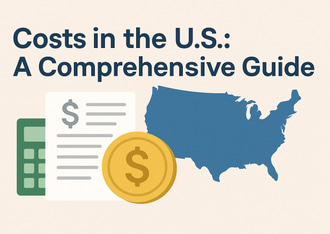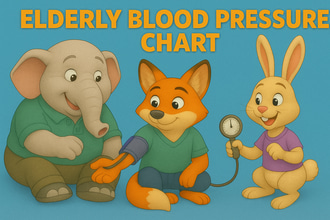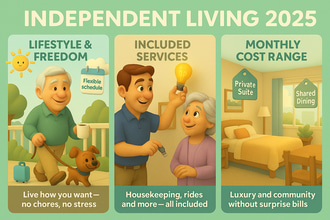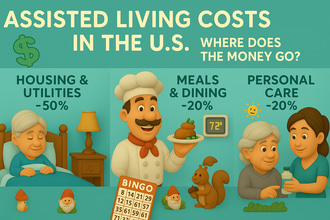Overview: A Growing Trend of Seniors in the Workforce
Americans are increasingly extending their careers into the traditional retirement years. Roughly one in five U.S. adults over 65 is now employed, a figure that has risen steadily over recent decades. In fact, a record 11.2 million Americans age 65 and older are currently in the workforce, and that number is projected to climb to 14.8 million by 2033 (about one in 12 workers). This reflects a broader trend: older workers today are generally healthier and better educated than previous generations, enabling longer work lives. Policy shifts such as a higher Social Security retirement age and the move from traditional pensions to 401(k)s have also contributed to seniors staying employed longer. Medical advances and improved longevity mean many people in their late 60s and 70s have the ability and desire to remain productive in the workforce.
However, national averages mask wide variation across different states. Some states have nearly double the senior workforce participation of others. According to recent data, the share of seniors working ranges roughly from the mid-20s (percent) at the high end to the low teens at the low end. As of 2023, Vermont (~25.6%), Iowa (~23.9%), and Maryland (~23.4%) had the highest proportions of people 65 and up still working, while West Virginia (~13%), Mississippi (~14%), and Arkansas (~15%) had the lowest. By 2024, these rankings shifted slightly (as we’ll see below), but the gap between the top and bottom states remained striking – on the order of a two-fold difference. The following sections highlight which states lead and lag in senior workforce participation in 2024, how those figures changed from 2023, and what might be driving these patterns.
State-by-State Senior Workforce Participation
Nationally, the workforce participation rate for seniors (typically those aged 65 and older) remains a critical indicator of both economic health and personal necessity. As of 2024, many states are seeing a continued rise in senior employment, driven by longer lifespans, financial needs, and growing opportunities for flexible work.
But the picture varies dramatically by state.
| State | 2023 | 2024 | % Increase or Decrease Year over Year |
| AL | 15.50% | 16.50% | 6.45% |
| AK | 21.70% | 22.50% | 3.69% |
| AZ | 15.00% | 15.20% | 1.33% |
| AR | 14.60% | 14.30% | -2.05% |
| CA | 17.90% | 17.70% | -1.12% |
| CO | 22.70% | 21.00% | -7.49% |
| CT | 22.40% | 23.00% | 2.68% |
| DE | 17.90% | 16.90% | -5.59% |
| FL | 18.60% | 18.20% | -2.15% |
| GA | 17.20% | 18.40% | 6.98% |
| HI | 21.80% | 22.00% | 0.92% |
| ID | 17.40% | 16.30% | -6.32% |
| IL | 19.20% | 21.20% | 10.42% |
| IN | 18.50% | 16.20% | -12.43% |
| IA | 23.90% | 20.40% | -14.64% |
| KS | 19.60% | 22.00% | 12.24% |
| KY | 16.00% | 15.20% | -5.00% |
| LA | 20.90% | 18.40% | -11.96% |
| ME | 18.10% | 20.00% | 10.50% |
| MD | 23.40% | 23.70% | 1.28% |
| MA | 22.20% | 24.20% | 9.01% |
| MI | 18.90% | 17.10% | -9.52% |
| MN | 20.90% | 18.20% | -12.92% |
| MS | 13.60% | 16.40% | 20.59% |
| MO | 16.00% | 17.00% | 6.25% |
| MT | 20.60% | 19.80% | -3.88% |
| NE | 22.40% | 23.90% | 6.70% |
| NV | 18.70% | 20.30% | 8.56% |
| NH | 20.60% | 22.80% | 10.68% |
| NJ | 21.10% | 23.80% | 12.80% |
| NM | 15.10% | 17.30% | 14.57% |
| NY | 19.30% | 20.00% | 3.63% |
| NC | 18.50% | 17.50% | -5.41% |
| ND | 20.60% | 22.80% | 10.68% |
| OH | 15.80% | 18.40% | 16.46% |
| OK | 21.80% | 23.20% | 6.42% |
| OR | 17.00% | 17.20% | 1.18% |
| PA | 18.40% | 18.20% | -1.09% |
| RI | 19.40% | 23.70% | 22.16% |
| SC | 17.30% | 17.90% | 3.47% |
| SD | NA | NA | NA |
| TN | 16.50% | 15.00% | -9.09% |
| TX | 19.70% | 20.40% | 3.55% |
| UT | 21.30% | 20.00% | -6.10% |
| VT | 25.60% | 25.80% | 0.78% |
| VA | 21.10% | 21.20% | 0.47% |
| WA | 17.20% | 16.30% | -5.23% |
| WV | 13.30% | 13.70% | 3.01% |
| WI | 16.00% | 16.20% | 1.25% |
| WY | 20.80% | 22.50% | 8.17% |
| DC | 21.60% | 22.30% | 3.24% |
| Nationally | 18.70% | 18.90% | 1.07% |
Table 1: Top 5 states with the highest workforce participation among seniors in 2024. Each of these states has roughly a quarter of its senior population still working, far above the national average (~18.9%)
Vermont leads the nation with about 25.8% of seniors engaged in work in 2024. This is notable, and in line with Vermont’s status in 2023 as well – Vermont was already a leader, reflecting its older population and perhaps a strong culture of continued work. Many Vermont seniors may be working part-time, in family businesses, or in civic roles, extending their careers rather than fully retiring. Vermont (along with neighboring New Hampshire and Maine) has one of the oldest median populations in the country, which can translate to a higher share of older folks in the labor force simply because there are more of them around. But demographics alone don’t tell the whole story – it’s also about whether those older residents choose or need to work.
Nebraska is another top state, with 23.9% of seniors working. Nebraska’s high ranking underscores that this phenomenon isn’t limited to the coasts or big cities. In Nebraska (and similarly in the Dakotas and other Plains states), a strong agricultural and small-business economy likely keeps many older individuals engaged in work. It’s common in farming communities, for example, for people to continue working the farm or family business well past typical retirement age. The work ethic and lifestyle in such states often encourage seniors to “keep going” if they are able. Additionally, labor markets in these states can be tight – with low unemployment – so employers may actively retain or recruit older workers to fill jobs.
Several East Coast states also make the top-five list. New Jersey (23.8%) and Maryland (23.7%) both boast nearly a quarter of seniors still working. These states are relatively affluent, high cost-of-living areas, which can incentivize longer careers. For instance, New Jersey has notoriously high property taxes and overall living expenses; even well-off retirees might find they need extra income or prefer to keep working to maintain their standard of living. It’s reported that even older adults with comfortable savings in high-cost regions still feel financial strain due to expenses like housing and healthcare, which can encourage post-retirement employment. Moreover, New Jersey and Maryland have many white-collar and professional job opportunities (e.g. government, education, consulting, etc.) where older workers can continue in flexible or part-time roles. Seniors in these states may also have higher levels of education on average, correlating with jobs that are less physically demanding and more accommodating to older employees. National research shows that today’s older workers are better educated and often in less physically strenuous careers than previous generations, enabling them to work longer by choice.
Rhode Island, at 23.7%, saw its senior labor force participation surge in 2024 (as we’ll explore shortly). By 2024 it joined the top tier of states. Rhode Island’s jump suggests that a significant number of older Rhode Islanders either delayed retirement or returned to work in the past year. Possible reasons range from economic necessity – Rhode Island’s cost of living has risen, and some retirees may have felt compelled to go back to work – to a strong local job market that has drawn in older workers. It could also reflect a rebound from earlier pandemic retirements: Rhode Island may have experienced more early retirements during 2020–2021, with those individuals “un-retiring” in 2023–24 as conditions improved. We know nationally that nearly a third of retired Americans have been considering rejoining the workforce due to the high cost of living. In fact, 71.6% of retirees who mulled returning to work cited inflation as a key reason. Rhode Island’s seniors may exemplify this trend – faced with rising prices and eroding savings, more are picking up jobs or continuing to work longer than planned.
It’s worth noting that high senior workforce participation isn’t confined to one region or type of state. The top five above include New England (VT, RI), Mid-Atlantic (NJ, MD), and the Great Plains (NE). This mix suggests there are multiple paths to the same outcome. In some states it may be driven by economic necessity or high costs (e.g. New Jersey), in others by cultural norms and work opportunities (e.g. Nebraska), and in others by a combination of factors like health, education, and lifestyle (e.g. Vermont’s seniors remaining active by choice). But what they share is an environment where a large share of older adults continue to earn a paycheck past 65.
States with the Lowest Senior Workforce Participation
On the other end of the spectrum, several states have relatively low engagement of seniors in the labor force. In these states, many more people transition fully out of work by their mid-60s. As of 2024, the lowest senior workforce participation rates (around 15% or less) are seen in a cluster of mostly Southern states and retirement destinations. Notably, West Virginia sits at the bottom with only about 13.7% of seniors still working. Arkansas is next around 14.3%, and other states in the bottom tier include Tennessee (~15.0%), Kentucky (~15.2%), and Arizona (~15.2%). By comparison, these figures are well under the national average (18–19%) and roughly half of what we see in the leading states.
These low-participation states share some common characteristics. Many are lower-income states with longstanding economic and health challenges. For instance, West Virginia, Kentucky, and Arkansas consistently rank near the bottom on health indicators for older adults (such as rates of chronic illness and disability). Unsurprisingly, poor health is a major factor that pushes people into retirement earlier than planned – research confirms that “poor health leads to early exit from work”, a relationship supported by substantial evidence. In states like West Virginia or Kentucky, higher rates of disability and physically demanding careers (e.g. mining, manufacturing, manual labor) mean that by age 65, many simply cannot continue working even if they might need or want to. These states also tend to have lower life expectancies, which correlates with fewer people able to remain in the workforce at older ages.
Another factor is the availability of job opportunities suitable for seniors. In more rural or economically depressed areas, there may be fewer part-time, flexible, or less physically intense jobs for older workers to take on. An older person in a small Appalachian town, for example, might not have many employment options beyond strenuous work, which isn’t feasible for them – whereas a senior in a suburban New Jersey town might find a low-impact job or consulting gig. Age discrimination could play a role as well: some of the low-ranking states have higher rates of age-related workplace discrimination complaints, suggesting less welcoming job markets for older workers. Mississippi (historically among the lowest senior workforce states) has reported an especially high rate of age-discrimination complaints, which could deter seniors from staying in or returning to work.
States with the Largest Increases
Several states enjoyed substantial growth in the share of seniors working year-over-year. Table 2 lists the top five states by percentage increase in senior workforce participation.
| State | % Working, 2023 | % Working, 2024 | YoY Increase |
| Rhode Island | 19.40% | 23.70% | 22.20% |
| Mississippi | 13.60% | 16.40% | 20.60% |
| Ohio | 15.80% | 18.40% | 16.50% |
| New Mexico | 15.10% | 17.30% | 14.60% |
| New Jersey | 21.10% | 23.80% | 12.80% |
Table 2: States with the largest percentage increases in senior (65+) workforce participation from 2023 to 2024. (YOY Change represents the relative increase in the share of seniors working.)
It’s worth mentioning a few other states that, while not in the top five, also saw notable increases. Kansas, North Dakota, New Hampshire, Maine, and Illinois all experienced roughly 10% or greater relative jumps in their senior workforce participation rates (each adding around 2 percentage points to their 2023 levels). In many of these cases, the reasons likely mirror those discussed: tight labor markets pulling in older workers, and seniors responding to economic incentives to stay employed.
States with the Largest Decreases
On the flip side, a number of states witnessed significant declines in the share of seniors working from 2023 to 2024. Table 3 shows the five states with the most pronounced year-over-year drops:
| State | % Working, 2023 | % Working, 2024 | YoY Decrease |
| Iowa | 23.90% | 20.40% | –14.6% |
| Minnesota | 20.90% | 18.20% | –12.9% |
| Indiana | 18.50% | 16.20% | –12.4% |
| Louisiana | 20.90% | 18.40% | –12.0% |
| Michigan | 18.90% | 17.10% | –9.5% |
Table 3: States with the largest percentage decreases in senior workforce participation, 2023–2024. (A negative change indicates a decline in the share of seniors working year-over-year.)
It’s notable that three of the top five decliners are Midwestern states (Iowa, Minnesota, Indiana) that had relatively high senior workforce participation to begin with. This suggests a possible regional trend of the Midwest “catching down” a bit – perhaps due to policy (like Iowa’s tax change) or simply a timing of retirements hitting that region. In contrast, the South (except Louisiana) didn’t feature as much in the biggest drops; many Southern states were already low and some even increased (like Mississippi).
The New Map of Retirement and Work
The data on senior workforce participation by state for 2023–2024 paints a vivid picture of how Americans are redefining retirement. Some are forging “encore” careers or remaining at work out of passion or necessity, while others are stepping away as soon as they can – and where they live often influences that choice. We see states like Vermont, Nebraska, and New Jersey at the forefront of this working-senior wave, with about a quarter of their older residents gainfully employed. On the other end, places like West Virginia, Kentucky, and Arizona have a majority of their seniors fully retired, with only a small minority still working. These differences speak to the underlying economic, health, and policy landscapes in each region.
Understanding these trends is important for both policymakers and businesses. For policymakers, the fact that roughly 19% of Americans over 65 are working (and rising) is a sign that retirement is not a one-size-fits-all age anymore. Policies around Social Security, Medicare, and taxation may need to adapt to a world where many seniors continue to earn income and seek employment opportunities. State governments, in particular, might consider how to make workplaces more age-friendly – for example, combating age discrimination, encouraging flexible work arrangements, or providing training for older adults – especially if they want to retain those workers and the economic contributions they make. States with very low senior participation might ask if there are barriers they can remove (such as improving older adult health programs or facilitating part-time job matching for seniors), both to improve seniors’ financial security and to tap a willing labor pool. Conversely, states with very high senior work rates should ensure that those working seniors have the support they need (like appropriate healthcare and protections on the job), and that those who cannot work are not left behind.
In conclusion, the variation in senior workforce participation across states is a window into the challenges and opportunities of aging in America. Whether it’s the farmer in Iowa finally hanging up his hat because a new tax break made it feasible, or the retired nurse in Rhode Island returning to work because inflation bit into her budget, each data point has a human story. Those stories collectively tell us that retirement is no longer a uniform experience at age 65 – it’s increasingly a spectrum, influenced by where we live, our financial realities, our health, and our personal choices. As more seniors continue “working through the golden years,” they are reshaping both the economy and societal expectations of later life. Understanding these patterns allows us to better support this generation in finding the right balance between work, financial security, and well-deserved rest in their later years.











































































